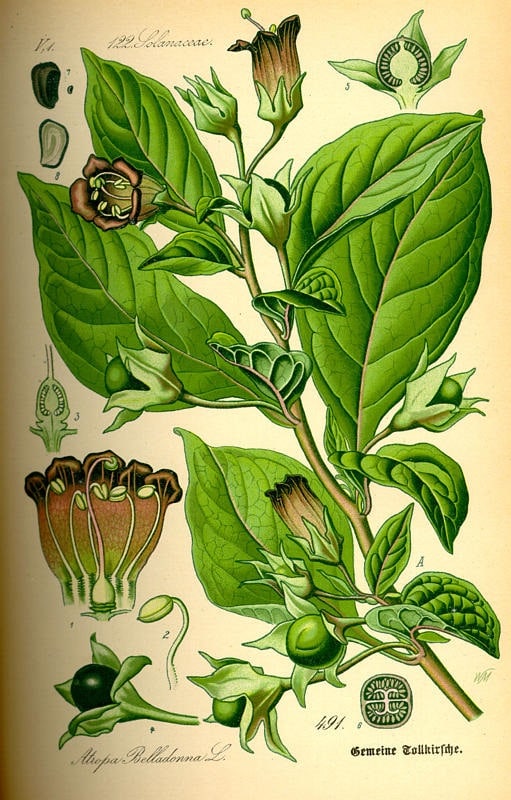
Mascarpheus Nadragulya – Atropa Belladonna
Detailed description of Nadragulya:
Atropa Belladonna Old or known by other names: dream-weed, fool’s bane, fool’s weed, buffalo seed, wolfberry, black or wolf cherry, matraguna, big grass, big-leaved plum, devil’s weed Nadragulya is a perennial plant. Its roots sprout and it develops annual green shoots from year to year. Its root is fleshy, thick, growing straight down into the ground, with few branches; it grows to 40 cm. long and thickens to 5 cm. at the top. In good soil it can reach 1.5 m into the ground. Roots yellowish brown outside, white inside. The older stems tend to produce several stems. Stems often 1-2 m tall, 1-2 cm thick at the base, usually with 3 main branches, and densely branched at the top, glabrous, slightly inbred above, greenish, often with a slightly reddish tinge at the base. The leaves are large, resembling tobacco, scattered on the stem, pedunculate, ovate, pointed, with intact margins, the stem tapering into the stem. The upper leaf blade is glabrous, dark green, the veins are lighter and glandular hairy, and therefore greasy to the touch. On the upper, or flower-bearing, side of the stem, the leaves are arranged in neat twos, one larger and one smaller. Its flowers stand singly in the axils of the leaves, supported by one larger and one smaller leaf. The flowers are pedunculate, slightly drooping. Outside the flower has a greenish calyx with 5 lobes, within which is the pistil, which is in one piece, grown into a tube, the top flaring out in a bell-shape, the flange in five lobes. The pads are a dirty brownish purple colour, the base is yellowish white, the sides are brownish veined, the tube is yellow inside. There are 5 stamens in the tube of the pistil, and the flower has the pistil in the centre, which produces a berry after flowering. The berry is green at first, but later becomes a beautiful, bright black colour with a strong glossy sheen, and the berry is very similar to a black cherry. When crushed, the rosy foliage releases a blue juice The berry as well as the whole plant is very poisonous! The nadragulya flowers from June to August.
Occurrence of Nadragulya:
 Nadragulya grows in the mountains, primarily in deciduous woodlands where it can be found along the edges of shady forests, and in ditches alongside deep streams and roadsides. Nadragulya is most abundant in beech woods, especially in the cuttings of beech forests. It likes calcareous soils and rich soil. It has become rare in places because it has been eradicated by logging. For this reason, it is now cultivated artificially; in England and America, for example, and in our country, it would be worthwhile to encourage the cultivation of this herb. However, wild nightshade has been valued more highly than cultivated nightshade, and it has recently been shown that cultivated nightshade has the same effect as wild nightshade. Therefore, it should be artificially propagated in forests, woodland clearings and clearings. Its seeds should be sown in the autumn or planted out in a hotbed, like tobacco. It can also be grown in the garden. It prefers deep, well-drained, sandy soil rich in flax. It is widespread throughout central and southern Europe, beyond northern Asia Minor to the Caucasus, generally in all hillside woodlands, deforestation, especially on limestone and basalt soils.
Nadragulya grows in the mountains, primarily in deciduous woodlands where it can be found along the edges of shady forests, and in ditches alongside deep streams and roadsides. Nadragulya is most abundant in beech woods, especially in the cuttings of beech forests. It likes calcareous soils and rich soil. It has become rare in places because it has been eradicated by logging. For this reason, it is now cultivated artificially; in England and America, for example, and in our country, it would be worthwhile to encourage the cultivation of this herb. However, wild nightshade has been valued more highly than cultivated nightshade, and it has recently been shown that cultivated nightshade has the same effect as wild nightshade. Therefore, it should be artificially propagated in forests, woodland clearings and clearings. Its seeds should be sown in the autumn or planted out in a hotbed, like tobacco. It can also be grown in the garden. It prefers deep, well-drained, sandy soil rich in flax. It is widespread throughout central and southern Europe, beyond northern Asia Minor to the Caucasus, generally in all hillside woodlands, deforestation, especially on limestone and basalt soils.
Effects of mesialgic nadragulya:
 The nightshade is a very poisonous plant! The whole plant, but especially the root and berries, contain a very strong poison, which atropine called. This poison is one of the most important and powerful remedies used against eye diseases. The atropine dilute solution of this substance, when dripped into the eye, makes the eye larger, more open and dilates the pupil atropine in the examination and operation of the diseased eye, but it also has a therapeutic effect on the eye. In the south, women, especially Italians, use the juice of the berry as a lubricant and drip it into the eye, because it makes the eye more open and brighter. Hence the name ‘bella donna’, meaning ‘beautiful woman’. When ingested, nightshade acts on the brain and senses, causing dizziness, stupor and double vision, intoxication. Our similarly poisonous plants are snapdragonand indendek!
The nightshade is a very poisonous plant! The whole plant, but especially the root and berries, contain a very strong poison, which atropine called. This poison is one of the most important and powerful remedies used against eye diseases. The atropine dilute solution of this substance, when dripped into the eye, makes the eye larger, more open and dilates the pupil atropine in the examination and operation of the diseased eye, but it also has a therapeutic effect on the eye. In the south, women, especially Italians, use the juice of the berry as a lubricant and drip it into the eye, because it makes the eye more open and brighter. Hence the name ‘bella donna’, meaning ‘beautiful woman’. When ingested, nightshade acts on the brain and senses, causing dizziness, stupor and double vision, intoxication. Our similarly poisonous plants are snapdragonand indendek!
Active ingredient:
 Atropine, hyoscyamine, scopolamine, tropane-based toxic alkaloids, plus a small amount of belladonin.
Atropine, hyoscyamine, scopolamine, tropane-based toxic alkaloids, plus a small amount of belladonin.
Antidote:
In case of poisoning, wash the head of the poisoned person with cold water, give him an emetic, strong coffee, vinegar or lemon juice (1906)
Cultivation of Nadragulya:
This plant, which prefers shady, damp woods or woodland, is cultivated by sowing seeds or by division. The plant requires 50×60 cm of space. One catastrophic acre requires 500 grams of seed or 40,000 seedlings. Yield per catastrophic acre: 6-8 q leaves and 8-10 q roots.
Harvesting:
Nadragulya is(are) a sought-after commodity. In medicine, the root and leaf are used, the former radix belladonnaethe latter herba or folia belladonnae under the name. When collecting and drying it, be careful, as it is a very poisonous plant. Children especially should be careful not to eat the beautiful and attractive berries. To collect the roots, dig up the roots of three-year-old plants. In the first two years, it is not worth digging up the needles, as they are thin and the roots of 3-4 year old plants are the richest in atropine. When the roots are dug, they must be dug deep, because sometimes the roots can penetrate up to 1 m into the ground. The thick roots are cut off and stuffed into a bag and sent home, while the thin ones are either put back in the ground or planted to propagate the needle tuber.  The roots are dug up in spring or July-August. Once dug, the roots are cleaned of soil and mud and cut lengthwise into several lengths to make them easier to dry. The cut roots are spread out on a tarpaulin and left to dry in the sun; if it is not sunny, they are dried in a heated room. 4 kg of fresh roots will yield 1 kg of dried roots. The leaves are taken from plants 2-4 years old. It is best to pick the leaves when the plants are in flower, but especially when the coneflower is in the flowering stage. The leaves should be picked clean and transported home in a basket, where they are immediately spread out thinly in the attic or in a shady, airy place. The leaves should be turned several times during drying. When picking and drying the leaves, remember that the cleaner the leaves are picked, the lighter the green colour and the fewer the stems and stalk parts, the greater the value of the dried leaves. Once the leaves are perfectly dry, they can be stuffed into a wool bag and tightly weighed down. 6 kg of fresh leaves will yield 1 kg of dry leaves. Occurrence Medicinal properties Active ingredient Collection Cultivation Source: Dr. Ferenc Darvas and Dr Gyula Magyary-Kossa,Domestic herbs, their production, marketing, effects and medicinal uses Béla Páter, Wild medicinal plants, their production, use and distribution
The roots are dug up in spring or July-August. Once dug, the roots are cleaned of soil and mud and cut lengthwise into several lengths to make them easier to dry. The cut roots are spread out on a tarpaulin and left to dry in the sun; if it is not sunny, they are dried in a heated room. 4 kg of fresh roots will yield 1 kg of dried roots. The leaves are taken from plants 2-4 years old. It is best to pick the leaves when the plants are in flower, but especially when the coneflower is in the flowering stage. The leaves should be picked clean and transported home in a basket, where they are immediately spread out thinly in the attic or in a shady, airy place. The leaves should be turned several times during drying. When picking and drying the leaves, remember that the cleaner the leaves are picked, the lighter the green colour and the fewer the stems and stalk parts, the greater the value of the dried leaves. Once the leaves are perfectly dry, they can be stuffed into a wool bag and tightly weighed down. 6 kg of fresh leaves will yield 1 kg of dry leaves. Occurrence Medicinal properties Active ingredient Collection Cultivation Source: Dr. Ferenc Darvas and Dr Gyula Magyary-Kossa,Domestic herbs, their production, marketing, effects and medicinal uses Béla Páter, Wild medicinal plants, their production, use and distribution
